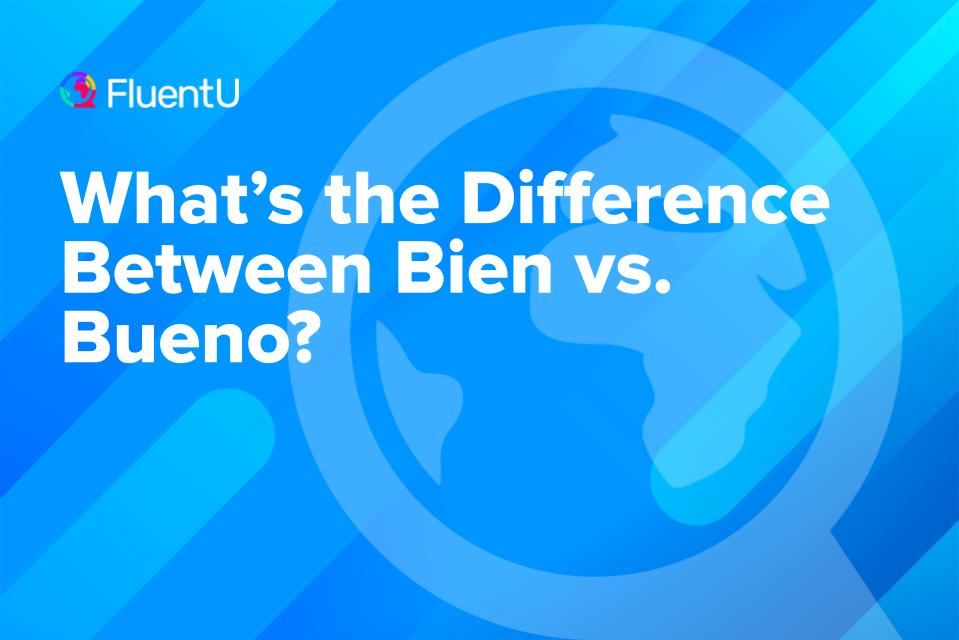Contents
- The Difference Between Bien vs. Bueno
- Uses of Bien
- 1. To answer ¿Cómo estás? and ¿Cómo te va? questions
- 2. To talk about your health
- 3. To emphasize the adjective in a sentence
- 4. When something is done correctly/properly
- 5. When something works or does not work as it should
- 6. When the answer to a question is okay, sure, fine or all right
- 7. To say “Yahoo!” or “Great!”
- Examples of bien in context
- Uses of Bueno / Buen
- 1. When someone behaves well
- 2. When a person fulfills their duty correctly
- 3. When something is beneficial for you
- 4. When something is useful or practical
- 5. When the quality of an object is high
- 6. When something is tasty
- 7. When someone is attractive
- 8. When the answer to a question is okay, sure, fine or all right
- Bueno vs. buen
- Examples of bueno in context
- Frequently Asked Questions
- And One More Thing…
What’s the Difference Between Bien vs. Bueno?

Do you “cook good” or are you “well at cooking?” If those phrases make you cringe, then you should know that you can mix up these words in Spanish as well.
The Spanish words bien, bueno and buen have similar meaning (good/well), but are used in different situations.
Download: This blog post is available as a convenient and portable PDF that you can take anywhere. Click here to get a copy. (Download)
The Difference Between Bien vs. Bueno
Simply put, bien is an adverb that is translated as “well.” On the other hand, bueno is an adjective that can be generally translated as “good.”
Even though these two words have completely different functions in the sentence, they are very often mistranslated or misused, both in Spanish and English, leading to many incorrect sentences as a result.
However, learning the difference isn’t as tricky as you may think:
Here are some examples of the way bien is used.
Mi primo no se siente muy bien. (My cousin is not feeling very well.)
Hazlo bien o no lo hagas. (Do it properly [well] or don’t do it at all.)
And here are some examples of the way bueno is used.
Juan es un niño muy bueno. (Juan is a very good boy.)
Fumar no es bueno para tu salud. (Smoking is not good for your health.)
Uses of Bien
Although bien is often translated as “well,” it can also be translated to “very,” “properly” and “fine.”
It’s an adverb, and as such, it can be used to modify a verb, adjective or another adverb. You may also see bien on its own to form a sentence.
Here are the main uses of bien:
1. To answer ¿Cómo estás? and ¿Cómo te va? questions
¿Cómo estás? (How are you?)
Bien, gracias, ¿y tú? (Fine, thanks, and you?)
2. To talk about your health
María no se siente muy bien hoy. (María is not feeling very well today.)
Ya estoy bien, pero los últimos meses han sido muy duros. (I’m fine now, but the last few months have been very hard.)
Note that in this context when talking about health, bien can also be used with the verbs sentirse (to feel) or encontrarse (to be/find yourself).
3. To emphasize the adjective in a sentence
If you add the adverb bien in front of an adjective, you emphasize it:
El examen estuvo bien difícil. (The exam was so difficult.)
Esta sandía está bien jugosa. (This watermelon is really juicy.)
4. When something is done correctly/properly
¡Qué bien cocinas, Alejandro! (Alejandro, you cook so well!)
Has entendido la lección muy bien. (You have understood the lesson very well.)
5. When something works or does not work as it should
Creo que mi ordenador no funciona bien. (I think my computer is not working properly.)
Esta mañana estaba trabajando bien. (This morning it was working correctly/fine.)
6. When the answer to a question is okay, sure, fine or all right
Nos vemos a las cinco en el parque. (See you at five p.m. in the park.)
Bien. (Okay.)
7. To say “Yahoo!” or “Great!”
Has ganado un osito de peluche, ¡Bien! (You have won a teddy bear, yahoo!)
¡Qué bien! Ya he terminado los deberes. (Great! I have finished my homework.)
Examples of bien in context
- ¿Todo bien? — Is everything all right?
- ¡Bien hecho! — Well done!
- Ahora bien — However, having said that, now
- Está bien — It’s okay/fine, all right
- Así está bien — That way is fine
- Bastante bien — Quite well
- Bien visto — Considered acceptable, well-regarded
- Caer bien — To make a good impression, to be liked/likable
- Portarse bien — To behave well
- Ir bien — To go well
- Ni bien — As soon as
- Ni bien ni mal — So-so
Uses of Bueno / Buen
Bueno is the adjectival counterpart of the word bien, and as such, it behaves very differently.
For starters, bueno has four forms that always have to agree in gender and number with the noun it refers to:
- Bueno (masculine singular)
- Buena (feminine singular)
- Buenos (masculine/mixed plural)
- Buenas (feminine plural)
Although the first meaning for bueno you will see in the dictionary is “good,” it can also mean “tasty,” “useful,” “beneficial” and even “hello!”
Here are the main uses of bueno/buen:
1. When someone behaves well
Andrés es un buen estudiante. (Andrés is a good student.)
Mi hijo es un niño muy bueno. (My son is a very good kid.)
2. When a person fulfills their duty correctly
María es muy buena madre. (María is a very good mother.)
Él es bueno en su trabajo. (He is good at his job.)
Mis hermanas son buenos jugando fútbol. (My sisters are good at playing soccer.)
3. When something is beneficial for you
Fumar no es bueno para la salud. (Smoking is not good for your health.)
Hacer ejercicio es muy bueno. (Exercising is very good/beneficial.)
4. When something is useful or practical
Es un libro muy bueno. (It is a very good book.)
Creo que es una buena impresora. (I think it is a good printer.)
5. When the quality of an object is high
Es un coche muy bueno. (It is a very good car.)
Necesito un buen sofá. (I need a good sofa.)
6. When something is tasty
Estas hamburguesas están muy buenas. (These hamburgers are really tasty.)
7. When someone is attractive
Whether you decide to use it or not is up to you, but remember this is very informal.
Lukas está muy bueno. (Lukas is very hot.)
8. When the answer to a question is okay, sure, fine or all right
This is the only situation in which you can use bien and bueno interchangeably and no one will bat an eye.
I am including the same example I used with bien so you can see for yourself there is actually no difference:
Nos vemos a las cinco en el parque. (See you at five p.m. in the park.) — Bueno. (Okay.)
Bueno vs. buen
Bueno and buen are actually two facets of the same word.
Their meaning is identical, but their position in the sentence is different.
Bueno is used after a masculine singular noun, but this word also has the possibility of appearing in front of the same masculine singular nouns. In this case, bueno has to lose its final -o in order to be able to be in that position:
Es un niño muy bueno. (He is a very good child.) → Es un muy buen niño. (He is a very good child.)
Es un melón bueno. (It is a tasty melon.) → Es un buen melón. (It is a tasty melon.)
The best way to learn how these words differ is to hear them being used in different contexts, like when talking to Spanish speakers or watching Spanish videos.
Another great option to master these tricky words is FluentU, which teaches Spanish through authentic videos.
FluentU takes authentic videos—like music videos, movie trailers, news and inspiring talks—and turns them into personalized language learning lessons.
You can try FluentU for free for 2 weeks. Check out the website or download the iOS app or Android app.
P.S. Click here to take advantage of our current sale! (Expires at the end of this month)

Examples of bueno in context
- Bueno — Well, so
- ¿Bueno? — Hello? (on the phone, only used in Mexico)
- ¡Bueno! — Enough already!
- ¡Qué bueno! — Awesome! Good to know! Great!
- Ser bueno en algo — To be good at something
- Bueno para nada — Good for nothing
- Bueno, pues — OK, then; enough already
- Dar por bueno — To give the go-ahead
- En las buenas y en las malas — Through thick and thin
- Por muy bueno que sea — As good as it might be
- Sacar lo bueno — To look on the bright side
Frequently Asked Questions
Should I say qué bien or qué bueno?
Both qué bien and qué bueno can be used to express satisfaction or approval about how something is done or how a situation turns out:
Aprobé mi examen. — ¡Qué bien! (I passed my exam. —Great!)
Aprobé mi examen. — ¡Qué bueno! (I passed my exam. —I’m glad!)
Just note that qué bien is more commonly used, so you may hear it more often than qué bueno.
Should I say muy bien or muy bueno?
Muy bien is typically used to express approval or satisfaction about how something is done or how a situation has turned out, indicating that it was done well or satisfactorily:
Muy bien, eso es todo por hoy. (All right, that’s everything for today.)
On the other hand, muy bueno describes something as being very good or pleasant in quality. So, if you want to praise someone’s performance or acknowledge a job well done, muy bien would be more appropriate. However, if you’re commenting on the quality or desirability of something, such as food or a product, muy bueno would be the better choice.
Este platillo está muy bueno. (This dish is really good.)
Everything is going to be bien if you study these two words properly.
And as they say, todo lo bueno se acaba (all good things must come to an end), so see you in the next post!
Download: This blog post is available as a convenient and portable PDF that you can take anywhere. Click here to get a copy. (Download)
And One More Thing…
If you've made it this far that means you probably enjoy learning Spanish with engaging material and will then love FluentU.
Other sites use scripted content. FluentU uses a natural approach that helps you ease into the Spanish language and culture over time. You’ll learn Spanish as it’s actually spoken by real people.
FluentU has a wide variety of videos, as you can see here:

FluentU brings native videos within reach with interactive transcripts. You can tap on any word to look it up instantly. Every definition has examples that have been written to help you understand how the word is used. If you see an interesting word you don’t know, you can add it to a vocab list.

Review a complete interactive transcript under the Dialogue tab, and find words and phrases listed under Vocab.

Learn all the vocabulary in any video with FluentU’s robust learning engine. Swipe left or right to see more examples of the word you’re on.

The best part is that FluentU keeps track of the vocabulary that you’re learning, and gives you extra practice with difficult words. It'll even remind you when it’s time to review what you’ve learned. Every learner has a truly personalized experience, even if they’re learning with the same video.
Start using the FluentU website on your computer or tablet or, better yet, download the FluentU app from the iTunes or Google Play store. Click here to take advantage of our current sale! (Expires at the end of this month.)







